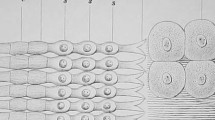Abstract
THE spermatozoa of a variety of species respond to mechanical stimuli and to other physical and chemical alterations in the environment by changing speed and pattern of movement, amplitude, frequency and length of the flagellar wave, as well as membrane potential1–4. The propagation of the flagellar wave thus cannot be attributed entirely to an autonomous oscillator, but must be influenced in a “neurochemical” fashion analogous to smooth muscle control systems.
Similar content being viewed by others
References
Nelson, L., Biol Reprod., 6, 319 (1972).
Nelson, L., Exp. Cell Res., 74, 269 (1972).
Gaddum, P., Anat. Record, 161, 471 (1968).
McGrady, A. V., and Nelson, L., Exp. Cell Res., 73, 192 (1972).
Mann, T., in Biochemistry of Semen and the Male Reproductive Tract, 2nd ed., 209 (Methuen, London, 1964).
Koelle, G. B., in The Pharmacological Basis of Therapeutics (edit. by Goodman, L. S., and Gilman, A.), 4th ed., 601 (Macmillan, New York, 1970).
Dryl, S., Acta Protozool., 7, 325 (1970).
Author information
Authors and Affiliations
Rights and permissions
About this article
Cite this article
NELSON, L. Preliminary Evidence for Cholinoceptive Sites in the Excitability of Spermatozoa. Nature 242, 401–402 (1973). https://doi.org/10.1038/242401a0
Received:
Issue Date:
DOI: https://doi.org/10.1038/242401a0
- Springer Nature Limited
This article is cited by
-
Analysis of sperm cell motion in high viscosity Newtonian and non-Newtonian fluids using a microfluidic channel
Microfluidics and Nanofluidics (2024)




